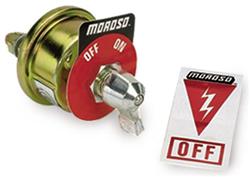You guys might want to listen
The "crash guys" should be able to run up to the car, KNOW that they can "kick at" the disconnect and KILL ALL POWER and that the disconnect will kill the engine as well as get rid of all power in the car
That toggle switch is not gonna do you any good if you are laying there half goofy in the driver seat and likewise that no6, no 4 charging line from battery to alternator makes a fine welding wire if it does not go through the disconnect
You can thank "all that tom foolery" when you are laying there upside down with fuel running down your nose, eh?
The secret to the toggle switch is make sure the alternator is turned off before the run. We had a toggle switch on a Mopar that opened the field circuit. It was mounted so it pointed up in the off position. A crew member would look in the car and make sure the driver had all switches in the up position, that meant the fuel pump, water pump, fan, and alternator were ready to race.
Also, why have the parasitic drag of an alternator charging while you're making a run?




















